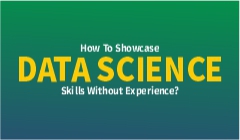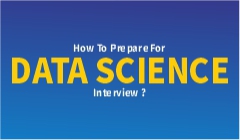
Entering the field of data science without previous work experience may seem daunting—but it's definitely doable. Most successful data scientists began with no conventional job in the industry. What made them exceptional? An effective plan to demonstrate their abilities through projects, portfolios, networking, and ongoing education.
In data science, your skills are more important than your job titles. Employers don't care to see a list of previous jobs, but they do care to see evidence of what you can do. The problem is proving those skills when you don't have an official track record. The good news is that you can provide that evidence yourself.
Why Skills Matter More Than Experience in Data Science
Before jumping into strategies, let's first grasp why demonstrated competence usually trumps formal work experience in data science:
Practical Work is Worth More than Words – Actual projects illustrate your problem-solving approach.
Technology Changes Fast – Employers prefer current skills to outdated knowledge.
Portfolio Hiring – Most companies screen candidates via coding exercises and project portfolios.
Demonstrated Passion and Initiative – Self-initiated work demonstrates motivation and commitment.
Step-by-Step Plans to Demonstrate Data Science Skills Without a Work Record
Here's a step-by-step plan to demonstrate your capabilities even if you have no work experience in a data science position.
1. Create a Strong Data Science Portfolio
A portfolio is the most critical tool for demonstrating your skills without experience.
What to include:
Portfolio-building tips:
2. Develop Real-World Projects
You may be able to do practical data science projects even without paid projects.
Simple project ideas for beginners:
Why this is effective:
Projects serve as proof-of-work for employers, demonstrating you can grab a problem, seek out data, and provide results.
3. Work on Open-Source Data Science Projects
Working on open-source projects demonstrates collaboration, coding expertise, and exposure to the real world.
How to get started:
Bonus: Several recruiters look up GitHub for active contributors during the hiring process.
4. Participate in Data Science Competitions
Competitions are a great source to demonstrate your skill without any work experience.
Where to compete:
Advantages:
5. Share Your Work Publicly
Sharing your knowledge online establishes your credibility.
Content sharing ideas:
Why this works:
Employers view you as a contributor to the data science world, not as a job applicant.
6. Earn Certifications and Badges
Certifications will not do away with experience but can confirm your learning.
Useful certifications are:
Pro Tip: Include certification badges on your LinkedIn page and portfolio website.
7. Network with Industry Professionals
Networking is not merely about discovering job leads—it's about learning, mentorship, and visibility.
How to network effectively:
Why it works:
Sometimes, your first opportunity comes through someone who’s seen your work rather than through a formal application.
8. Tailor Your Resume to Highlight Skills Over Experience
Without job history, your resume should be skills-focused:
Sections to include:
Tip: Use action verbs like analyzed, developed, implemented, and optimized.
9. Display Soft Skills in Addition to Technical Skills
Interviewers appreciate communication, collaboration, and problem-solving as much as technical skill.
How to exhibit soft skills:
10. Update and Continue Learning
Data science is not static—new tools and approaches arise regularly.
Ideas for ongoing learning:
Common Mistakes to Avoid
In creating your data science profile with no experience, avoid these mistakes:
Conclusion
It is not only possible but also increasingly common to land a data science job without work experience. By creating a solid portfolio, working on open-source, taking part in competitions, publishing your work, networking, and continuously learning, you can show you're employable.
Keep in mind, data science skills are the new money. If you can tackle problems, get value from data, and present insights simply, employers will take notice, short of your work history
Begin today with your first project, document it thoroughly, post it openly, and continue to build your portfolio. The more concrete evidence you have of your skills, the sooner you'll land that first data science job.

When you are about to join the competitive job market—be it data science, software development, or any other field of IT—one question comes to mind: "How many projects should I do before applying for jobs?"
This is a key aspect as your portfolio tends to be the initial consideration of employers. Your certifications and educational background are important, but it's your workable, tangible achievements that make you stand out.
The reality is that there’s no fixed magic number for projects. Instead, the focus should be on quality, diversity, and relevance of projects to the role you’re targeting. The goal is to build a portfolio that reflects your skills, problem-solving ability, and readiness to handle real-world challenges.
Before discussing the numbers, let’s understand why projects are essential:
Quality vs. Quantity in Project Work
When planning your portfolio, remember:
Quality wins over quantity – 3–5 strong, well-documented projects are far better than 10 unfinished or shallow ones.
Relevance is key – Projects should align with the job roles you’re applying for.
Demonstrate breadth and depth – Include a mix of simple and complex projects.
Show different skills – For example, data cleaning, visualization, machine learning, or web application development.
Optimal Number of Projects Prior to Seeking Employment
That there is no one-size-fits-all rule, there's this general guideline based on industry experience and recruiter expectations:
Beginners / Fresh Graduates:
Experienced Professionals Looking to Move Up:
Types of Projects to Have in Your Portfolio
To achieve most impact, your projects must be:
Here's a categorization of project types deserving consideration:
1. Foundational Skill Projects
2. Intermediate-Level Projects
3. Domain-Specific Projects
4. Collaborative or Open-Source Projects
5. Capstone Projects
These are end-to-end, large-scale solutions that demonstrate actual job problems.
How to Structure Your Portfolio for Maximum Impact
When posting projects on GitHub, personal websites, or portfolios:
Write a concise README – Problem statement, dataset information, tools utilized, and end results.
Feature your role – Particularly in group projects.
Present results graphically – Charts, screenshots, or demo videos.
Make it straightforward to navigate – Keep folders and code well-organized.
Mistakes to Avoid When Creating Your Project Portfolio
Most job applicants make unnecessary errors when creating their portfolios:
Why Hiring Managers Are Interested in Projects Than Ever Before
In today's job market:
How to Finish Projects Quicker and Better
How Many Projects Are Enough for a Job Application?
In summary:
Beginners: 3–5 high-quality projects.
Career Changers: 5–7 relevant projects.
Experienced Professionals: 7–10 impactful projects.
But remember—relevance, execution quality, and documentation matter far more than raw numbers.
Conclusion
There is no one-size-fits-all answer to "How many projects should I do before applying for jobs?" but having 3–7 relevant, well-documented, and well-executed projects will set you ahead of most candidates. Your portfolio should demonstrate not only your skills but also your capacity to problem-solve, work with data, and deliver results through clear communication.
Focus on creating a balanced mix of projects that demonstrate both technical and problem-solving skills, and you’ll be well-prepared to impress recruiters and hiring managers.

Introduction
Data science is among the most sought-after and competitive profession today. Companies are looking for individuals who can decipher complicated data, create predictive models, and push actionable insights. If you are looking for a data science position, cracking the interview takes more than programming skills—it needs a combination of technical skills, analytical mind, problem-solving skills, and business acumen.
Preparing for a data science interview can be daunting because it encompasses several areas: statistics, programming, machine learning, and applications related to your domain. But with a systematic approach, you can prepare yourself step by step and tackle the panel with confidence.
Throughout this guide, we will discuss how to prepare for a data science interview—key skills, typical questions, tips for practicalities, and ways to present your skills in the best possible way.
Main Areas to Master for Data Science Interviews
You should be aware of the key areas interviewers tend to test, prior to going through preparation techniques:
Programming Skill – Python, R, SQL, or whichever language is appropriate.
Statistics & Math – Probability, hypothesis testing, linear algebra, and calculus.
Machine Learning Concepts – Algorithms, model evaluation, hyperparameter tuning.
Data Manipulation & Analysis – Dealing with dataframes, cleaning, and feature engineering.
Data Visualization – Utilizing libraries such as Matplotlib, Seaborn, Tableau, or Power BI.
Problem-Solving & Case Studies – Implementing methods to resolve business problems.
Communication Skills – Describing technical content in non-technical language.
Step-by-Step Guide to Preparing for a Data Science Interview
Step 1: Understand the Job Description and Role Requirements
Read the job description carefully before preparing to know:
This will allow you to order your preparation and target the skills that are most important for that particular job.
Step 2: Enhance Your Core Programming Skills
Hands-on coding problems are the norm in most data science interviews.
Programming areas of focus:
Tips to practice:
Step 3: Master Data Wrangling and Exploratory Data Analysis (EDA)
Employers would like to know whether you can take raw data and make it into a usable state.
Skills you need to know:
Step 4: Brush Up on Statistics and Probability
Statistics is the foundation of data science.
Items to refresh:
Step 5: Revise Machine Learning Fundamentals
You should be able to describe and apply standard machine learning algorithms.
Algorithms to practice:
Supervised learning: Linear regression, logistic regression, decision trees, random forest.
Unsupervised learning: K-means clustering, PCA.
Model evaluation: Confusion matrix, ROC curve, precision-recall, RMSE.
Step 6: Learn About Big Data Tools (If Needed)
There are some companies which may demand knowledge of big data frameworks such as:
Step 7: Prepare for Case Study and Business Problem Questions
Interviewers usually evaluate practical problem-solving ability with case studies.
Advice on solving case studies:
Step 8: Practice Common Data Science Interview Questions
Some of the most common data science interview questions are:
Step 9: Create a Good Portfolio
A portfolio demonstrates your abilities with actual projects. Add:
Step 10: Improve Communication Skills
Data scientists frequently deal with non-technical stakeholders. Practice:
Mock Interview Practice
Advantages of mock interviews:
Consider practicing with a mentor or colleagues to mimic actual interview stress.
How to Approach Technical Coding Rounds
Behavioral and HR Interview Preparation
Apart from technical competencies, HR rounds are about soft skills and cultural alignment.
Potential questions:
Time Management for Prep
A 3-4 week prep schedule might be this:
Week 1: Review programming and SQL.
Week 2: Statistics, ML concepts, and EDA.
Week 3: Case studies practice and mock interview.
Week 4: Portfolio refinement and final review.
Last-Minute Tips to Ace Your Data Science Interview
Conclusion
Preparing for a data science interview requires a balanced focus on technical expertise, analytical thinking, and communication skills. By mastering programming, statistics, machine learning, and problem-solving, you’ll be ready to tackle technical rounds with confidence. Complement your technical preparation with a strong portfolio and polished communication skills, and you’ll greatly increase your chances of success.